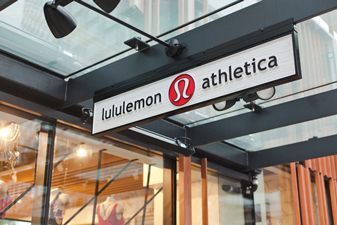
lululemon is a Canadian designer and manufacturer of innovative athletic apparel for yoga, running and other athletic pursuits. What began as an idea to create a healthy and active living community hub in Vancouver has transformed into an impressive business with 302 retail locations worldwide and more than 2000 employees in Canada alone.
The strategic use of intellectual property (IP) has been central to the continued growth of the brand. The company protects its products with industrial designs, patents and trademarks in Canada and around the world.
Distinct logo and brand name (trademarks)
A business' brand is one way it can stand out from its competitors. Erin Nicholas, Vice-President of Legal and Corporate Secretary, says: “Having a distinctive name and a distinctive logo has been an advantage for us.” From the beginning, consumers were attracted to the large lululemon logo on the front of retail establishments and over time, the logo has become associated with the lululemon brand. lululemon also has trademark protection for many of its product names and fabrics names, including Luontm, Booluxtm and Luxtremetm.
Innovative designs and function (industrial designs and patents)
At the heart of fashion are fresh new designs. A substantial amount of money is invested in creating new and original designs each season. Industrial design can provide tangible protection to the fashion industry as it protects the visual features of shape, configuration, pattern or ornament, or any combination of these features that appeal to the eye. Distinctive and attractive features give products a competitive edge. For fashion items with a long lifespan, registering an industrial design may be the best way to prevent others from copying it, but consideration must be done on a case-by-case basis.
lululemon is known for design that is rooted in function while always looking beautiful, and is constantly exploring new concepts and technologies. Its work in creating Silverescent® (anti-stink) products, compression (Engineered Sensation) and multiple proprietary and newer fabrics, including Nulu® (Align Panttm), Warpstreme® (ABC panttm), and Evonaturalstm is an example of lululemon's innovation.
The company has numerous patent and industrial design registrations throughout the world protecting aspects such as designs, fabrics and production methods. “We're absolutely a design-led company, all the way through, and that's in every part of our DNA as a company,” said Kieran Moore, lululemon's intellectual property counsel. IP has been integral to lululemon's business strategy from the beginning, and it is working!
lululemon holds 45 registered industrial designs in Canada and 48 design patents in the U.S. alone, most of which provide protection for athletic wear designs. In Canada, a registered industrial design provides you with five years protection with the possibility of extending your protection for an additional 5 years.
IP best practices for small businesses
lululemon has grown tremendously since the company opened its doors in 1998. Erin Nicholas and Kieran Moore share some valuable advice for Canadian SMEs just starting out:
- Think IP from the beginning: it's a key resource and a tremendous asset for your company
- Research IP before investing in research and development
- In doubt, get IP information and industry advice from people with experience and expertise
- Ingrain IP knowledge into your business; educate your employees about IP
- Determine where to spend your IP dollars; it may not be prudent to protect everything a company creates in all countries
- Consider the use of trade secrets as an alternative to patents
lululemon has created a successful, distinct and well-recognized brand, in part because of the strategic use of IP. lululemon's journey from a Vancouver community hub to a global business is a prime example of IP strategy at work!
